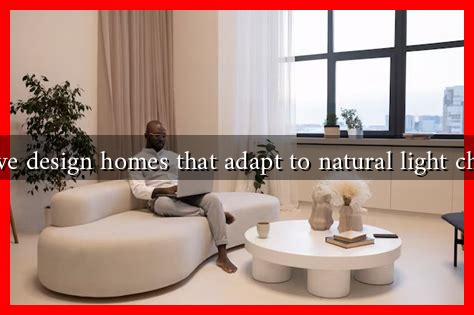-
Table of Contents
Can We Design Homes That Adapt to Natural Light Changes?
As the world becomes increasingly aware of the importance of sustainability and energy efficiency, the concept of designing homes that adapt to natural light changes is gaining traction. This innovative approach not only enhances the aesthetic appeal of living spaces but also promotes well-being and reduces energy consumption. In this article, we will explore the principles behind adaptive home design, examine existing technologies, and discuss the potential benefits of such homes.
The Importance of Natural Light in Home Design
Natural light plays a crucial role in our daily lives, influencing our mood, productivity, and overall health. Research has shown that exposure to natural light can:
- Improve mental health and reduce stress levels.
- Enhance productivity and focus.
- Regulate circadian rhythms, leading to better sleep quality.
- Reduce energy costs by minimizing reliance on artificial lighting.
Given these benefits, it is essential to consider how homes can be designed to maximize natural light while adapting to its changes throughout the day and across seasons.
Adaptive Design Principles
Adaptive home design involves creating spaces that can respond to varying light conditions. This can be achieved through several architectural and technological strategies:
- Dynamic Facades: Buildings can be equipped with adjustable exterior elements, such as louvers or shades, that respond to the sun’s position. For example, the Al Bahar Towers in Abu Dhabi feature a dynamic facade that opens and closes based on sunlight intensity, reducing heat gain and glare.
- Smart Windows: Technologies like electrochromic glass allow windows to change tint in response to sunlight, helping to control heat and light levels inside the home. This technology is being utilized in various commercial buildings and is gradually making its way into residential designs.
- Daylight Harvesting: This approach involves using sensors to monitor natural light levels and adjust artificial lighting accordingly. By integrating daylight sensors, homes can automatically dim or brighten lights based on the amount of natural light available.
- Open Floor Plans: Designing open spaces with strategically placed windows can enhance the flow of natural light throughout the home. This design principle is evident in many modern homes, where large, unobstructed windows are a focal point.
Case Studies and Examples
Several innovative projects around the world exemplify the concept of adaptive home design:
- The Edge, Amsterdam: This office building is often cited as one of the greenest in the world. It features smart technology that adjusts lighting based on occupancy and natural light levels, creating a comfortable and energy-efficient environment.
- Solar Decathlon Projects: Various teams participating in the Solar Decathlon competition have showcased homes that utilize adaptive design principles. For instance, the University of Maryland’s “WaterShed” home incorporates a responsive facade that optimizes natural light and energy efficiency.
- Passive House Designs: Homes built to Passive House standards prioritize energy efficiency and often include features that maximize natural light while minimizing heat loss. These homes are designed to maintain comfortable indoor temperatures year-round.
The Future of Adaptive Home Design
As technology continues to advance, the potential for designing homes that adapt to natural light changes will only grow. Innovations in materials, smart home technology, and sustainable practices will pave the way for more responsive living environments. According to a report by the International Energy Agency, buildings account for nearly 40% of global energy consumption, highlighting the urgent need for energy-efficient designs.
Moreover, as climate change continues to impact weather patterns, adaptive homes can help mitigate the effects of extreme weather by optimizing energy use and enhancing comfort. The integration of renewable energy sources, such as solar panels, can further complement these designs, creating homes that are not only responsive to light but also self-sufficient.
Conclusion
Designing homes that adapt to natural light changes is not just a trend; it is a necessary evolution in architecture that prioritizes sustainability, health, and comfort. By leveraging innovative technologies and design principles, we can create living spaces that enhance our quality of life while reducing our environmental footprint. As we move forward, embracing adaptive design will be crucial in addressing the challenges posed by climate change and energy consumption.
For more information on sustainable architecture and adaptive design, visit ArchDaily.

